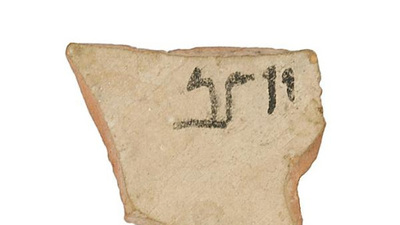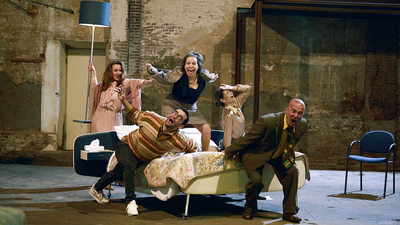Dear Friends, In May 2017, a student and contributor to the David Cardozo Think Tank by the name of Yael Valier launched a remarkable play of the famous “Disputation of Barcelona” between the legendary Jewish scholar Nachmanides, also called Ramban (1194-1270) and a Jewish convert to Christianity, named Pablo Christiani, concerning the truth of Judaism and Christianity. This debate was held over a period of 4 days in Barcelona and in front of King James 1 of Aragon in 1263.
This is by far the most famous disputation between Judaism and Christianity ever to take place. Nachmanides was victorious and was even rewarded by King James 1, but was ultimately forced by the Dominicans to leave Aragon (Spain) and he settled in Israel. Nachmanides recorded, from memory, the full dispute.
In our days Roy Dolinger wrote a play about the dispute called “Divine Right”.
Yael Valier who had just started her theater company in Jerusalem, named Theater and Theology, produced this play in Jerusalem in May 2017. The production became a huge success and was staged many times.
Since the David Cardozo Academy and Theater and Theology sometimes collaborate and have many similar goals, I participated in a discussion about this production when it was staged for the first time. This was a great honor.
In 2020, Yael wrote a paper on her experience and insight concerning this play, which was published by Emanuel University of Oradea Perichoresis in the same year.
No doubt this became a most important essay which reflects in many ways the David Cardozo Academy’s ideology and goals and also touches on my “Contemplative Autobiography”. We are therefore very thankful to Yael for allowing us to produce her essay, which appeared in the journal Perichoresis, in three parts in the next three weeks.
Nathan Lopes Cardozo
Perichoresis, ‘Dramaturgical and Theological Issues Involved in Producing and Staging a Play in Jerusalem about the Disputation of Barcelona’, Volume 18.4 (2020): 41–61.
DOI: 10.2478/perc-2020-0021
© EMANUEL UNIVERSITY of ORADEA PERICHORESIS 18.4 (2020)
DRAMATURGICAL AND THEOLOGICAL ISSUES INVOLVED IN PRODUCING AND STAGING A PLAY IN JERUSALEM ABOUT THE DISPUTATION OF BARCELONA, YAEL VALIER, DAVID CARDOZO ACADEMY
ABSTRACT. In the context of the launch of a new theater company whose mission is to bring entertaining theological content to audiences in and around Jerusalem, Roy Doliner’s Divine Right was chosen as the company’s first production. This play about the Disputation of Barcelona balances historical accuracy and creative dramatic content in a satisfying and intellectually honest portrayal of the events of the Disputation for educated lay audiences. Many theological and dramaturgical issues arise, especially in producing a play with a high level of Christian content and theology for mainly Orthodox or at least traditionally educated Jewish audiences.
English speaking audience members in Jerusalem tend to be well-informed, both on the historical level and on the level of Jewish law and mores. This makes them exacting viewers, critical of inaccuracies of history or interpretation, wary of challenging positions but mostly willing to learn, and delighted by thorough research and characterization. This paper examines the technical, dramaturgical, and theological issues that arose during this production for the playwright, director, actors, and audiences.
Introduction
In May of 2017, I launched a new theater company in Jerusalem, Theater and Theology, by staging a play about the Disputation of Barcelona. Theater and Theology’s mission is to bring thought-provoking theological issues to the public in an entertaining way. I had to choose my first play very carefully.
It had to be gripping and grand. After spending time searching for the appropriate play, the play found me. Roy Doliner, playwright and historian, had just moved to Jerusalem from Italy and was looking for a female director for Divine Right. He felt that a female director would recognize that the drama of the play lies in its nuanced portrayal of relationships, with the grander historical drama and intrigues providing the tension and informing the action. Though I firmly believe that a male director could be equally capable of a sensitive directing job, I was glad to take on the challenge.
In essence, the decisions I made vis-à-vis Divine Right encapsulate the issues underlying the production of any historical drama: Should the play be limited to as accurate a historical account as possible, or is creative license allowed? Does focusing on the ‘smaller’ truths of specific relationships and the impact of events on individuals highlight authentic issues that a straight historical account cannot convey to lay audiences? Considering the mission of the theater company, and the need to sell tickets in order to stay afloat financially, is it more the job and moral imperative of the director to educate or to entertain, and to what degree?
Jerusalem contains a highly educated, theologically and academically sophisticated public. The play chosen had to stand up to the public’s scrutiny and expertise, and, importantly, to its preconceived attitudes and deeply held beliefs. At the same time, it had to be an exciting, thought-provoking, and nuanced piece of theater.
Thus, the dramaturgical and theological implications of staging a play about the Disputation of Barcelona, particularly in Jerusalem for a mostly educated Jewish audience, are great and delicate. In this paper, I will summarize some of the issues involved, and explain my choice of play and the manner in which I chose to portray it.
Dramaturgical Issues
Technical Challenges
The first issue to consider when writing or staging a play about the Disputation of Barcelona is on which version of events to base oneself. For me, and for playwright Roy Doliner, the choice was clear. The terse Latin report of the event is not only sparse in detail, but, on a dramaturgical level, it is far less interesting. Much would have to be invented for lack of primary material, especially in order to realistically portray Nahmanides as incompetent and helpless during the debate. This position would also make it difficult for Jewish audiences familiar with Nahmanides’ erudite commentary on the Bible and mastery of the Talmud to suspend disbelief.
Furthermore, all audiences love the ultimate triumph of an underdog, not least an audience that identifies strongly with said underdog – all of which served to make Nahmanides’ report the clear choice of document on which to base the drama. Nahmanides’ report – without comment on whether it is actually the product of his hand, a retroactively constructed polemic by himself or by others, or a mix of all these things – reads like a screenplay, with large chunks of dialogue already delineated, quotable, and suitably daring and dramatic.
Choice of venue is an important factor to consider when staging a play. Physical environment influences audience appreciation, even if this is unconscious. Properly, Doliner’s play should include many extras cast as noble and plebian onlookers. However, Theater and Theology’s format includes a discussion between the audience and a theologian after each performance. Therefore, a small, intimate venue is preferable. This necessarily entails a small stage and, consequently, a limited cast. For me, the small stage at the Jerusalem Khan Theater, built on the ruins of an inn from the Crusader period, was perfect. The naked stone construction of the auditorium, including that providing the back wall of the stage, ensured that the environment was perfect from the moment the audience entered.
As Nina Caputo points out in her fascinating dissection of the process that went into the creation of her graphic novel, Debating Truth, deciding how to physically portray one’s characters is a complex issue. Caputo discusses the difficulty of figuring out what, exactly, people wore and how they were groomed in the second half of the 13th century, since ‘medieval art was not a literal or realist mode of representation.’ For example, she points out that ‘Many images of James I that were produced during his lifetime present him as clean-shaven. Beginning in the first quarter of the fourteenth century, though, artists typically represented James I with an impressive beard. Many medieval depictions of kings from this period do include beards, perhaps as a symbol of authority, power, and stability’ (Caputo 2016: 202).
In their consideration of the balance between drama and historical accuracy, Nina Caputo and Liz Clarke, her illustrator, generally made decisions that toe the historic line, to the best of their ability. This translated, for example, into their portrayal of James I without a beard. I modeled my James on the famous portrait found on the medieval altarpiece in Palma commemorating his conquest of Valencia. The impetus to do so was dramatic rather than historic. The various portraits of James I with a forked beard make him interesting to look at. As a director, that guided my choice for his character and for the others on stage.
Another example of where Divine Right’s characters diverged from the strictly historically accurate for the sake of drama is in the relative ages of Pablo Christiani and Nahmanides. If we accept Jeremy Cohen’s assertion that ‘probably as early as 1229, when Raymond de Penaforte had preached and missionized in Provence, Pablo converted to Christianity and quickly joined the Order of Preachers’ (Cohen 1953: 108), and the assumption that he already had a wife and children at that time, then he was at least close to Nahmanide’s age. Doliner, however, deliberately chose to portray Christiani as significantly younger than Nahmanides, and I supported this choice in my casting. The portrayal of Christiani as a younger, charismatic, energetic, and confident superstar vs. Nahmanides’ apparently tired old-age avoided the need for lengthy exposition through dialogue in order to set up the Church as the obvious favorite in the debate. It also served to make Christiani’s ultimate victory-in-name-only a more dramatic failure than if the visual portrayal of the two characters had been more balanced. In commenting on this and other choices, Doliner quotes David Henry Hwang, who claims that a dramatist’s job is not to parrot dry information but to tell a ‘truer truth’.
In deciding how to dress my characters, I opted to use what director William Ball called ‘uniforms’. Uniforms are costumes that include symbols, avoiding the necessity of having to tell a story through lengthy, undramatic dialogue. According to Ball, by ‘placing uniforms [on characters], the need for all that dialogue is obviated. It is clear that there are visual symbols in our culture that tell a story without words. A skillful director will have a very creative eye for the possibility of revealing the story through the visual symbols and not relying on the words’ (Ball 1984: 150). For Divine Right, for example, the use of uniforms translated into topping the Jewish characters with turbans. Though Jews do not appear to have worn turbans in Barcelona or Gerona in 1263, a turban, closely associated with a famous and completely imaginative 19th century portrait of Moses Maimonides, is a marker for Jews in the mind of Jewish audiences. Therefore, in this case, using turbans was an efficient method of clearly marking the Jews on the stage. Doliner insists that what makes Divine Right interesting, beyond the history lesson and the intellectual sparring involved, is the relationships it portrays. In order to efficiently and indelibly demarcate the opposing ‘teams’ in the play, I used uniforms, as one does in a sporting event. As such, I dressed Pablo Christiani in the threatening red habit of later Inquisitors, despite this being anachronistic, since the picture this ‘uniform’ conveys to audience members evokes a familiar and powerful reaction. Though the historic Pablo Christiani did not wear red robes, he was a terrible and potent threat to Nahmanides and to the Jewish community, as symbolized by those robes.
Some of the ‘uniforms’ in Divine Right were already handed to me by history. The habits of the Dominican and Franciscan friars, for example, which were already distinct in the 13th century, made the sub-plot of rivalry between the Dominican and Franciscan factions throughout the play easy to follow. The antipathy of the white-and-black garbed friars for those in grey, and vice versa, was highlighted for lay audience members who may not have caught on to their different identities and group loyalties by the opinions they expressed alone.
Props and set pieces, of course, are also critical in creating the correct atmosphere for any play. It should not be difficult to obtain set items such as paintings or posters of Jesus, the Madonna, and saints, in Israel. Neither should it be difficult to purchase props such as cross pendants. However, for an Israeli who covers her hair in a Jewish-Israeli style and who therefore cannot easily pass for a tourist, this is not necessarily as simple as it may seem. As an Israeli, though the town I live in is basically contiguous with Palestinian controlled Bethlehem, I am not allowed to enter Bethlehem. To do so as an Israeli is to break the law, and to do so as an identifiably religious Israeli Jew is to risk one’s life. Obviously, this made shopping in Bethlehem impossible for me. The Arab shuk in the Old City of Jerusalem is the next closest place to seek religious Christian items in my area of the country, but again, especially since I was doing my shopping during the Knifing Intifada, a person who dresses as I do is not untroubled in this setting. According to the Meir Amit Intelligence and Information Center, there were 21 ‘significant’ or substantially violent attacks on Israelis in April and May of 2017, precisely when I was doing my theater props shopping. Fourteen attacks occurred at the Damascus gate of the Old City – the gate between the Muslim and Christian Quarters – between September 2015 and April of 2017. Nevertheless, I did indeed go through the Arab shuk and to the Christian Quarter of the Old City for prop and set items. Since my spoken Arabic is unexpectedly decent, I had some measure of confidence in doing this. For the theological difficulties of purchasing and using such set items and props, see the Theological Issues section below.
Roy Doliner’s Divine Right compared to other historical dramas
To historically aware Jewish audiences, a story of Jew vs. Hostile Non-Jew, despised vs. favorite, has a mythical quality, with collective resonance and familiar tropes. Jews constantly live these themes from within their scripture, liturgy, and tradition. The Passover Seder, arguably the most widely celebrated Jewish ritual, is completely dedicated to the theme of the triumph of the underdog, through the agency of God, as it recalls and replays Jewish victimhood and redemption. The opposite side of the formula – the failure of the underdog to triumph – has strong roots in the Jewish annual cycle too, with four of the six Jewish fast days dedicated to commemorating destruction and expulsion during and in the aftermath of the first Temple, and one commemorating a failed genocide attempt during the exile in Persia. In short, the collective commemoration of incidents of Jew vs. Hostile Non-Jew in the Jewish tradition boils down to two easy formulae: They tried to kill us – they failed; let’s eat! or, They tried to kill us – they succeeded; let’s fast.
The Disputation of Barcelona fits easily into the Jewish psyche as an event of the They tried to kill us – they failed variety, and, in a way similar to Kabuki theater for Japanese audiences or Beijing Opera for Chinese ones, the audience finds comfort, community, and delight in its familiar themes and recognizable tableaux. Jews have been accused of many things over the centuries—of being capitalists and communists, misers and profligates, defiant recalcitrants and craven cowards, but never stupid. The picture of a lone Jewish scholar facing down a hostile army of questioners is one that fits neatly into the collective Jewish unconscious, and it is therefore one well calculated to draw Jewish audiences to the theater.
Doliner faced many challenges and choices when crafting his play. He found it necessary to take some dramatic liberties in order to render the story accessible and more theatrical. These include keeping the historic tone of the piece while maintaining its accessibility to the audience, keeping the story flowing, and portraying the now often obscure points of debate in a dramatic, comprehensible, terse, and entertaining manner. To this end, Doliner substituted some of the more obscure points of the debate for current issues still used by missionaries in their efforts to convert Jews.
It is worthwhile noting that Bertolt Brecht and Tom Stoppard faced the same issues when writing their respective plays about Galileo Galilei and his tribulations with the Church. Stoppard, who was hired by Paramount to write a screenplay in 1970 loosely based on Brecht’s 1943 play, decided to stick to a more historically accurate, less dramatic account of the life of Galileo. As a result of its lack of panache, Paramount rejected Stoppard’s screenplay, and it remained unproduced until it was adapted and played on the Edinburgh Fringe in 2004. Unvarnished history does not usually make for good theater, so a playwright must find a way to highlight themes and attitudes that are true and resonant, without being chained to particular events. For the honest playwright and director, this is a hard balance to maintain.
A play must have substance, tension, drama, and preferably humor, in order to entertain. Hyam Maccoby, a superb academic, wrote The Disputation, a play about the Disputation of Barcelona. Though the play has many qualities, it is less adapted to the sophisticated, religiously, and secularly educated English-speaking audience of Jerusalem. Maccoby’s play lacks a certain nuance and substance, rendering it a more appropriate choice, perhaps, for general audiences with no exposure to the times or the topic. Divine Right’s sell-out first and second runs show that Jerusalem audiences enjoy something they can sink their intellectual teeth into.
Beyond the need to keep the story dramatic, Doliner had to keep his audience constantly aware of the mortal danger of the Inquisition. Both Doliner and Maccoby portray the Catholic Church’s questioning of Nahmanides as part of the Inquisition, despite the fact that the Spanish Inquisition was only formally established in 1478. The Church in Aragon at the time of James I was influenced by the Medieval Inquisition and the establishment of the Papal Inquisition in 1232. As such, both playwrights refer to King Louis IX of France’s political and religious choices as having been heavily influenced by the Pope, including his call for the Disputation of Paris in 1240 and the subsequent burning of the Talmud in Paris. Both plays make reference to King James’ perception of himself as a candidate for excommunication if he were to defy the Church’s desires. And both plays make reference to James’ removal of the Bishop of Gerona’s tongue and the subsequent pressure applied to the king by the pope in order to have him prove his loyalty to the Church, as the following quotations will show:
Hyam Maccoby’s The Disputation, Act I, Scene 2:
RAYMOND SHOWS A BOX
KING JAMES (admiring box). Nice, eh? The finest ebony wood from Majorca. (Opens box) My, my, the Bishop had a long tongue. Display it in the town square.
RAYMOND DE PENAFORTE. Your Majesty, I must speak openly.
KING JAMES. Please do.
RAYMOND DE PENAFORTE. Pope Urban is outraged.
KING JAMES. The Bishop of Gerona brought it upon himself. He should not have spoken openly against the King.
RAYMOND DE PENAFORTE. He spoke against your infidelities.
KING JAMES. Well he’s a mute bishop now, isn’t he?
RAYMOND DE PENAFORTE. His Holiness feels that the incident is further proof of your lack of support for the Church. He has recommended your excommunication.
KING JAMES. That would not be good.
RAYMOND DE PENAFORTE. I have been able to delay this while we seek calm. I do think that if the Pope felt that you had more of an interest in converting the Jews to Christianity, so that our Saviour may return, he would be willing to re-examine the penalty.
To be Continued.
This publication was made possible with the support of the Louis and Dina van de Kamp Foundation, August 2020.






